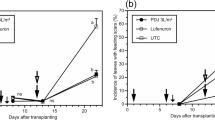Abstract
Epidemics of onion leaf spotcaused by Botrytis spp. depend onnecrotic leaf tissue for inoculum build up inthe crop. Ulocladium atrum Preuss. is astrong competitor on necrotic above-groundplant tissues. The potential of the antagonistto reduce colonisation of necrotic leaf tissueby Botrytis spp. and subsequentsporulation was studied in two fieldexperiments. U. atrum colonised necrotictissues and consistently reduced thesporulation of fungal competitors. Althoughincidence of Botrytis spp. was low,significantly lower spore loads of Botrytis spp. were found on spore trapslocated within U. atrum treated onionplots as compared to untreated control plots.The number of leaf spots caused by Botrytis spp. was low in both fieldexperiments but was significantly reduced by60% after U. atrum applications in thesecond experiment. Spraying of the fungicideRonilan resulted in the same control level.Results show that U. atrum has apotential for biological control against diseases caused by Botrytis spp. in onions.
Similar content being viewed by others
References
Boff, P., J. Köhl, W.A.G.M. Jansen, P.J.F.M. Horsten, C.H. Lombaers-van der Plas and M. Gerlagh, 2002. Biological control of grey mould with Ulocladium atrum in annual strawberry crops. Plant Disease 86: 220–224.
Hancock, J.G. and J.W. Lorbeer, 1963. Pathogenesis of Botrytis cinerea, B. squamosa, and B. allii on onion leaves. Phytopathology 53: 669–673.
Jarvis, W.R., 1980. Epidemiology. In: J.R. Coley-Smith, K. Verhoeff and W.R. Jarvis (eds), The Biology of Botrytis. Acad. Press, London, UK. pp. 219–250.
Kessel, G.J.T., B.H. de Haas, C.H. Lombaers – van der Plas, J.E. van den Ende, M.G. Pennock-Vos, W. van der Werf and J. Köhl, 2001. Comparative analysis of the role of substrate specificity in biological control of Botrytis elliptica in lily and B. cinerea in cyclamen with Ulocladium atrum. European Journal of Plant Pathology 107: 273–284.
Köhl, J. and M. Gerlagh, 1999. Biological control of Botrytis cinerea in roses by the antagonist Ulocladium atrum. Mededelingen Faculteit Landbouwkundige en Toegepaste Biologische Wetenschappen Universiteit Gent 64: 441–445.
Köhl, J., M. Gerlagh and G. Grit, 2000. Biocontrol of Botrytis cinerea by Ulocladium atrum in different production systems of cyclamen. Plant Disease 84: 569–573.
Köhl, J., M. Gerlagh, B.H. de Haas and M.C. Krijger, 1998. Biological control of Botrytis cinerea in cyclamen with Ulocladium atrum and Gliocladium roseum under commercial growing conditions. Phytopathology 88: 568–575.
Köhl, J. and W.M.L. Molhoek, 2001. Effect of water potential on conidial germination and antagonism of Ulocladium atrum against Botrytis cinerea. Phytopathology 91: 485–491.
Köhl, J., W.M.L. Molhoek, C.H. van der Plas and N.J. Fokkema, 1995a. Effect of Ulocladium atrum and other antagonists on sporulation of Botrytis cinerea on dead lily leaves exposed to field conditions. Phytopathology 85: 393–401.
Köhl, J., C.H. van der Plas, W.M.L. Molhoek and N.J. Fokkema, 1995b. Suppression of sporulation of Botrytis spp. as valid biocontrol strategy. European Journal of Plant Pathology 101: 251–259.
Köhl, J., C.H. van der Plas, W.M.L. Molhoek and N.J. Fokkema, 1995c. Selection of antagonists suppressing sporulation of Botrytis allii and B. cinerea after interrupted wetness periods. European Journal of Plant Pathology 101: 627–637.
Lorbeer, J.W., 1966. Diurnal periodicity of Botrytis squamosa conidia in the air. Phytopathology 56: 887.
Maude, R.B., M.R. Shipway, A.H. Presley and D. O'Connor, 1984. The effects of direct harvesting and drying systems on the incidence and control of neck rot (Botrytis allii) in onions. Plant Pathology 33: 263–268.
Nielsen, K., 2000. Molecular characterisation and biological control of grey mould (Botrytis spp.) in onion. PhD thesis Royal Veterinary and Agricultural University, Frederiksberg C, Denmark.
Schoene, P. and J. Köhl, 1999. Biologische Bekämpfung von Botrytis cinerea mit Ulocladium atrum in Reben und Cyclamen. Gesunde Pflanzen 51: 81–85.
Sutton, J.C., T.D.W. James and P.M. Rowell, 1986. BOTCAST:A forcasting system to time the initial fungicide spray for managing Botrytis leaf blight of onions. Agriculture, Ecosystems and Environment 18: 123–143.
Vincelli, P.C. and J.W. Lorbeer, 1989. Blight-Alert: A weather-based predictive system for timing fungicide applications on onion before infection periods of Botrytis squamosa. Phytopathology 79: 493–498.
Visser, de C.L.M., 1996. Field evaluation of a supervised control system for Botrytis leaf blight in spring sown onions in the Netherlands. European Journal of Plant Pathology 102: 795–805.
Yohalem, D.S., 2000. Microbial management of early establishment of grey mould in pot roses. 17. Danske Plantevarnskonference, DJF-rapport 12: 97–102.
Author information
Authors and Affiliations
Rights and permissions
About this article
Cite this article
Köhl, J., Molhoek, W., Goossen-van de Geijn, H. et al. Potential of Ulocladium atrum for biocontrol of onion leaf spot through suppression of sporulation of Botrytis spp.. BioControl 48, 349–359 (2003). https://doi.org/10.1023/A:1023614622179
Issue Date:
DOI: https://doi.org/10.1023/A:1023614622179




